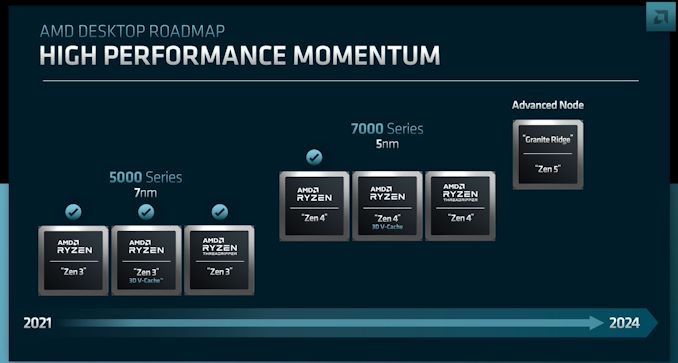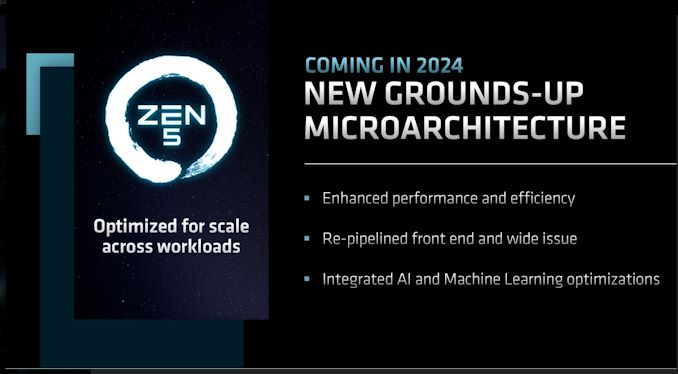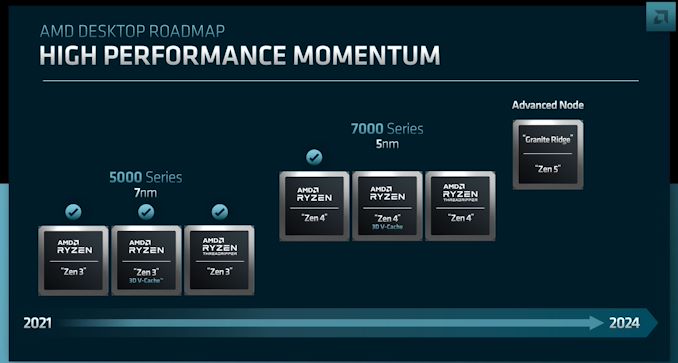AMD's Desktop CPU Roadmap: 2024 Brings Zen 5-based "Granite Ridge"
by Gavin Bonshor on June 9, 2022 6:50 PM EST- Posted in
- CPUs
- AMD
- roadmap
- TSMC
- Zen 4
- Zen 5
- V-Cache
- Ryzen 7000
- Granite Ridge
- AMD FAD 2022

As part of AMD's Financial Analyst Day 2022, it has provided us with a look at the company's desktop client CPU roadmap as we advance towards 2024. As we already know, AMD's latest 5 nm chips based on its Ryzen 7000 family are expected to launch in Fall 2022 (later this year), but the big news is that AMD has confirmed their Zen 5 architecture will be coming to client desktops sometime before the end of 2024 as AMD's "Granite Ridge" chips.
At Computex 2022, during AMD's Keynote presented by CEO Dr. Lisa Su, AMD unveiled its Zen 4 core architecture using TSMC's 5 nm process node. Despite not announcing specific SKUs during this event, AMD did unveil some expected performance metrics that we could expect to see with the release of Ryzen 7000 for desktop. This includes 1 MB per core L2 cache, which is double the L2 cache per core with Zen 3, and a 15%+ uplift in single-threaded performance.
AMD 3D V-Cache Coming to Ryzen 7000 and Beyond
One key thing to note with AMD's updated client CPU roadmap, it highlights some more on what to expect with its Zen 4 core, which is built on TSMC's 5 nm node. AMD is expecting 8-10% IPC gains over Zen 3, on top of their previously announced clockspeed gains. As a result, the company is expecting single-threaded performance to improve by at least 15%, and by even more for multi-threaded workloads.
Meanwhile AMD's 3D V-Cache packaging technology will also come to client desktop Zen 4. AMD is holding any further information close to their chest, but their current roadmap makes it clear that we should, at a minimum, expect a successor to the the Ryzen 7 5800X3D.
AMD Zen 5 For Client Desktop: Granite Ridge
The updated AMD client CPU roadmap until 2024 also gives us a time frame of when we can expect its next-generation Zen 5 cores. Built on what AMD is terming an "advanced node" (so either 4 nm or 3 nm), Zen 5 for client desktops will be Granite Ridge.
At two years out, AMD isn't offering any further details than what they've said about the overall Zen 5 architecture thus far. So while we know that Zen 5 will involve a significant reworking of AMD's CPU architecture with a focus on the front end and issue width, AMD isn't sharing anything about the Granite Ridge family or related platform in particular. So sockets, chipsets, etc are all up in the air.
But for now, AMD's full focus is on the Zen 4-based Ryzen 7000 family. Set to launch this fall, 2022 should end on a high note for the company.












35 Comments
View All Comments
Mikewind Dale - Thursday, June 30, 2022 - link
It's also possible that once the ThreadRipper is discontinued and only the ThreadRipper Pro remains, the ThreadRipper Pro will just become the ThreadRipper.Unashamed_unoriginal_username_x86 - Thursday, June 9, 2022 - link
"and up to a 15% performance uplight in single-threaded IPC performance."this doesn't make any sense, it says ">15% Single-Thread Uplift" in the article you link and you contradict it immediately below
wrkingclass_hero - Thursday, June 9, 2022 - link
Up to 15% IPC (instruction per clock) improvement, but it will also be clocked higher, so it will be greater than 15% in total single threaded performance.Yojimbo - Friday, June 10, 2022 - link
"AMD is expecting 8-10% IPC gains over Zen 3, on top of their previously announced clockspeed gains. As a result, the company is expecting single-threaded performance to improve by at least 15%, and by even more for multi-threaded workloads."8-10% IPC, but it will be clocked higher, so it will have greater than 15% in performance uplift.
Sttm - Thursday, June 9, 2022 - link
So if Zen 4 is a 15% bump, and the 5800X3D was a 15% bump, gaming performance should be similar and if you should just buy a 5800X3D and save the platform cost right?techjunkie123 - Friday, June 10, 2022 - link
I think zen 4 is going to be a 15-25% ST jump, and 20-40% MT jump. Most importantly, this is going to apply across most workloads, unlike X3D, which is only helpful is some applications (like gaming). I would expect higher tier Zen 4 to beat out the 5800X3D, and lower tier skus to maybe tie it. So it would depend on what you want out of the build. AM5 would be more future proof, since you can just upgrade to zen 5 later on.Also note that there will be zen 4 plus v cache at some point next year. That should be 10-15% bump over regular zen 4.
Yojimbo - Friday, June 10, 2022 - link
No, Zen 4 will not have a 15-25% jump in ST.techjunkie123 - Friday, June 10, 2022 - link
9% IPC increase plus 10% frequency (5.0 to 5.5 Ghz) increase equals 20% better ST.Khanan - Friday, June 10, 2022 - link
In reality it depends on the game. The 5800X3D is a god tier CPU in some games where the extra L3 cache makes it ultra fast, but one thing is sure, the 7800X3D will beat it.IBM760XL - Saturday, June 11, 2022 - link
The downside of that is you'd have to buy a new mobo and rebuild if you wanted to upgrade your CPU (to a 7800X3D, 8800X3D, etc.) later on.With AMD's long-term platform support, I'd probably buy the new platform, and have the upgradeability down the line, unless there was a really good deal on the old one.